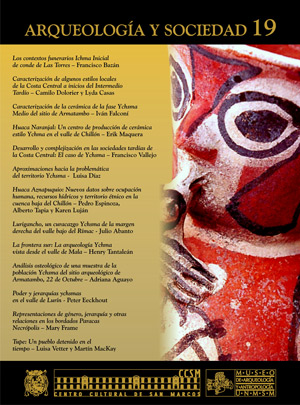CHARACTERIZATION OF SOME LOCAL STYLE OF THE CENTRAL COAST AT THE BEGINNING OF THE LATE INTERMEDIATE
DOI:
https://doi.org/10.15381/arqueolsoc.2008n19.e12696Keywords:
Huallamarca, Ichma Initial, transgressors styles, Orange Ornamental Style, Aquillado Style, Cream Blast Style, Geometric Tricolor StyleAbstract
This study aimed to characterize some of the ingredients typical of the ceramic phase Ichma Beginner, it is used exclusively for qualifying order stylistic parameters, to establish categories confrontations and contrasts. We believe that this is even necessary to create appropriate methodological tools to achieve results of greater explanatory scope and accuracy. In this process shows that the conformation of the different styles that make up the complex stylistic Ichma called Initial, involving both internal and external factors. Each has a different degree and mode of penetration and influence. In the second instance can be seen that the styles are not organized the same way. So much so that the form and decoration (where there are elements associated with the technique, composition and design), may each of them an independent movement, and to no stylistic traditions related to particular forms of organization. The study allowed us to distinguish the style of decorative styles and decoration forming stable units created. Moreover, we have a stable morphological style without decoration. Finally decorative styles “offenders”, which often break transversely into several distinct morphological units simultaneouslyDownloads
Published
Issue
Section
License
Copyright (c) 2008 Camilo Dolorier, Lyda Casas Salazar

This work is licensed under a Creative Commons Attribution-NonCommercial-ShareAlike 4.0 International License.
THE AUTHORS RETAIN THEIR RIGHTS:
a. The authors retain their trademark and patent rights, and also on any process or procedure described in the article.
b. The authors retain the right to share, copy, distribute, perform and publicly communicate the article published in the Arqueología y Sociedad (for example, place it in an institutional repository or publish it in a book), with an acknowledgment of its initial publication in the Arqueología y Sociedad.
c. The authors retain the right to make a subsequent publication of their work, to use the article or any part of it (for example: a compilation of their works, notes for conferences, thesis, or for a book), provided that they indicate the source. of publication (authors of the work, journal, volume, number and date).






